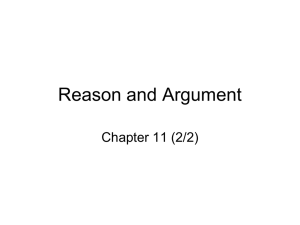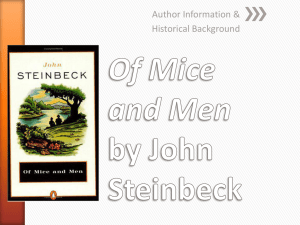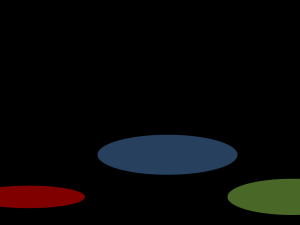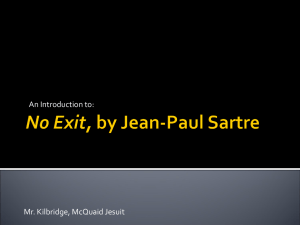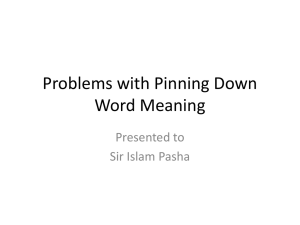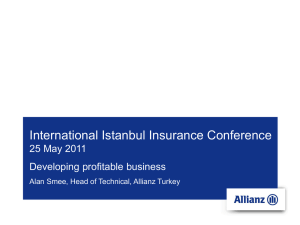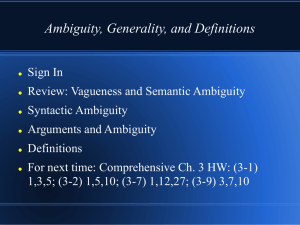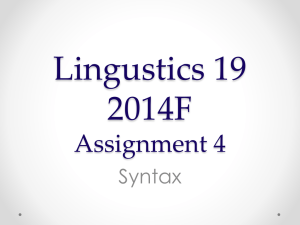Humor!_Final Presentation
advertisement
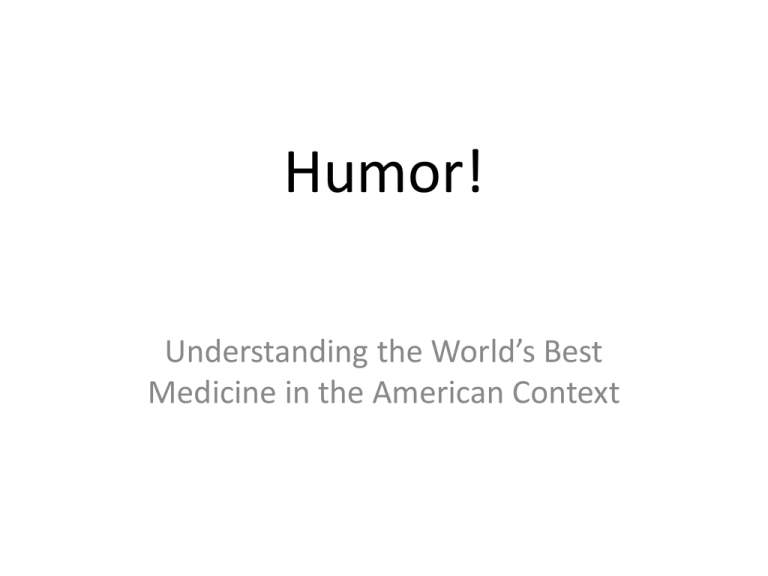
Humor! Understanding the World’s Best Medicine in the American Context Course Objectives Students Will Be Able To: •recognize and use adjectival suffixes to make adjectives out of nouns. •identify homonymy. •identify jokes (puns) made by taking advantage of homonymy •recognize and understand a list of idiomatic expressions. •identify jokes made from the idiomatic expressions. •]recognize syntactic ambiguity and by doing so have a better command of word roles •identify jokes made by taking advantage of syntactic ambiguity. •use vocabulary: ridiculous, ludicrous, outrageous, preposterous, syntactic ambiguity, lexical ambiguity, homonymy, puns •Recognize ‘what’ and ‘who’ as subjects. •Understand Abbot and Costello’s “Whose on First” •Answer questions about ambiguity from the listening “Hu’s the leader of China?” To be funny is to be: Ridiculous! Outrageous! Ludicrous! Preposterous! What do these words all have in common? 1. All are Adjectives 3. All end in (-ous) 2. All are contrary to our expectations 4. All are possibly: horrible or offensive Most important for the purposes of understanding Grammar: All are Adjectives + All end in -ous Attaching suffixes in order to Make Adjectives(-ous) Ridicule + (-ous) = Ridiculous Outrage + (-ous) = Outrageous Ludicrous = Ludicre? (-ical) (-ful) Economy + (-ical) = Economical Wonder+ (-fu) = wonderful Myth = ical = Mythical Power + (-ful) = powerful Cynical – Cyny?; Cyn? (-ic) Economy+(-ic) = Economic Irony + (-ic) = Ironic Spastic = Spasty? Spast? Awful – Awe?; Aw? (-al) Logic+ (-al) = logical magic+ (-al) = magical Final = Fin? Finic? Time for Worksheet A! Activity A Vocabulary Recap •Pitiful = to be deserving of or to inspire pity •Humongous = To be very big •Historical = To be of or pertaining to history •Intentional = To be done with purpose •Awful = to be terrible, lamentable •Ethical = to be in accordance with a particular set of principals •Historic = to be so influential or great as to be ensured a place in history •Literal = Strictly true and unexaggerated •Joyous = to inspire much joy. •Geographic = To do with location on Earth •Mirthful = To be characterized by good humor and light heart •Classic = to be the established and standard model – Classic Rock •Whimsical = to tend toward and embrace fantasy •Classical = Pertaining to somewhat antiquated – Classical Music •Humorous = To have or inspire humor •Geographical = To do with location on Earth. Ambiguity! Words or phrases that are ambiguous have at least 2 interpretations. A contextually ridiculous or outrageous interpretation of a word or phrase is the funny one. Lexical ambiguity gives rise to Puns ! Lexical ambiguity is often the result of Homonymy Homonymy describes groups of words that differ in meaning but have: the same spelling and pronunciation; the same spelling but different pronunciation; or different spellings but the same pronunciation. Examples: Same spelling and pronunciation 1) Bill Bill 3) Leaves Leaves 2) Tired Tired Same spelling, different pronunciation 1) Read Read 1) Live Live Different spelling, same pronunciation 1) Flower 2) Horse Hoarse Flour 3) Two To Too 4) Their There They’re Puns with Homonymy -A duck walks into a pharmacy and tells the pharmacist that he wants some chap stick. When the pharmacist asks the duck if he wants to pay cash or credit he says, “Just put it on my bill.” 1. Bill = The ducks beak or beak like organ 2. Bill = The account at a store or business to which we charge items we cannot pay for at that moment. -The bicycle can't stand on its own because it was two-tired. http://www.punoftheday.com/ 1. (Too) Tired = The bike is so tired it can no longer stand 2. (Two) Tired= The bike has two tires, and so it falls over for lack of support Time for Worksheet B! Semantic Ambiguity can also be used to make jokes/puns with Idioms Idioms are traditional expressions that often have a meaning quite different from their literal translation. Examples: 1) “To cost an arm and a leg” 2) “Excuse my French.” 3) “To see right through someone” 4) “To hit the nail on the head” 5) “To let the cat out of the bag” 6) “To let sleeping dogs lie” Literal Vs. Figurative -Literal is to be strictly true and unexaggerated; to be exact in meaning and description. -Figurative is to be metaphorical, not strictly true or exact in meaning. Idioms are figurative, in that they are metaphorical and not exact in meaning. Literal translations of idioms are a bit ridiculous, and thereby somewhat comical. ! Many times people say that something literally happened, when in fact they are exaggerating! Example: “The bullet passed literally in front of my nose.” -From this example we can surmise that the bullet came very close, however, it likely did not truly pass “in front of (his or her) nose”. Jokes with Idioms: http://www.foundstuff.co.uk/store/gas/gas15.jpg Puns with Idioms: http://www.iceteks.com/forums/uploads/post-15-1087588578_mitsoujunejpg.jpg Time for Worksheet C! Worksheet C - Directions Directions: Read the sentences or pun you have been given. Then try to find the person whose pun aligns with your sentences, or the person whose sentences align with your pun. Try to decide if the puns you read are funny or horrible. Worksheet C Example Grouping Yesterday I accidentally swallowed some food coloring. The doctor says I'm OK, but I feel like I've died (dyed) a little inside. Idiomatic Meaning : To have lost something vital and feel terrible Ridiculous Meaning: To have the color of the internal organs changed Jokes can be made by taking advantage of Syntactic Ambiguity as well! Syntactic Ambiguity is when the relationships of words in a sentence are not entirely clear, and can change the interpretation of the sentences overall meaning. Examples: 1) A panda walks into a restaurant and eats shoots and leaves. 2) The chicken is ready to eat. 3) Eye Drops Off the Shelf. Syntactic Ambiguity The chicken is ready to eat. http://www.needofmeats.co.uk/images/imagebank/uploads/Cooked_Chicken_Fillet s.jpg http://www.istockphoto.com/file_thumbview_approve/4803404/2/istockphoto_48 03404-hungry-chicken.jpg Syntactic/Semantic Ambiguity A panda walks into a restaurant and eats shoots and leaves. http://www.mammalz.com/UserFiles/2007/5/25/panda _eating_3370_473.jpg http://bayimg.com/image/ganlhaabl.jpg Time for Worksheet D! Newspaper Headlines = Ambiguous Headlines - When writing newspaper headlines, many times an editor will write incomplete sentences in order to save space on the page. Examples: - Eye Drops Off the Shelf = “Eye drops are available to be bought off of the shelf” -Miners refuse to work after death = “Miner’s refuse to work after the death of a co-worker.” Worksheet D – Directions Directions: Some students have pictures while others have ambiguous headlines. Students with pictures must move about the room until they find the two students who are holding headlines relevant to each of their pictures. Students with pictures are not allowed to show their pictures but must describe them to other students. Students with headlines are not allowed to share their headline with other students unless they believe that that student’s picture pertains to their headline. Worksheet D - Example A panda walks into a restaurant and eats shoots and leaves. http://www.needofmeats.co.uk/images/imagebank/uploads/Cooked_Chicken_Fillet s.jpg http://www.mammalz.com/UserFiles/2007/5/25/panda _eating_3370_473.jpg http://bayimg.com/image/ganlhaabl.jpg Time for Worksheet E! The Role of What and Who -Unlike why, where, and how who, what, can serve as the subject of a sentence. Examples: Q. Who stole my car? A. Who did it should be obvious. Q. What happened? A. What happened is regrettable. **Unlike** Q. Where are your favorite stores? A. Where I like to go is Meijer. Q. Why does he do it?/Why do they do it? A. That is why. Q How is she?/How are they? A. That is how she is. Who’s on First! Second base Man on second: __________ First base Third base Man on first: ‘Who’ Man on third: __________ Home base Click here to start: http://www.youtube.com/watch?v=77azRkVHtqM&feature=related Time for Worksheet E! Hu’s (Who’s) The new leader in China Hu Jintao http://www.humanrights.cn/en/Messages/Video /W020080102316736004178.jpg Kofi Annan http://farm1.static.flickr.com/140/320165172 _90773e80db_m.jpg Yasser Arafat http://www.smh.com.au/ffximage/2005/10/24/Y asser_051024022914127_wideweb__300x375.jp g Homonymy in Review! Go here to start: http://www.funnyordie.com/videos/b2288e0a1f/hu-is-theleader-of-china-from-ron Time for Worksheet F!
